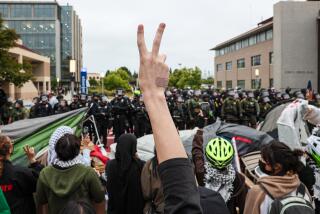Opinion: USC student protest: Did the school really have to call their parents?
When 18 USC students staged a sit-in Tuesday outside the office of university President C.L. Max Nikias to protest the school’s business dealings with a vendor — the parent company of which has ties to factories in Bangladesh — school officials took a tough stance. The students were told that if they didn’t pipe down or get going by the end of the business day, they would be given “a letter of interim suspension,” as Ainsley Carry, the vice provost of student affairs, said later in a statement. (No one got suspended.) They were also told they risked losing their university scholarships. (That would be as a result of the suspensions, which didn’t happen.)
Then officials really played hardball: They threatened to call the students’ parents. And they did. Francesca Bessey, one of the students occupying the hallway outside the president’s office in Bovard Hall, wrote in Neon Tommy, the online student-run news site: “I, personally, was informed by my father that the school would be suspending me for being too loud.”
The students left the building at 6:30 p.m. after a three-hour sit-in.
So let me get this straight: Fewer than two dozen students sit down in a corridor at 3:30 in the afternoon, demanding to see the president of the university to talk about the school’s policy toward a vendor that might be doing business in sweatshop-plagued Bangladesh, and the university official who deals with students comes down and threatens to suspend them, imperil their scholarships and tell their parents?
What would the school have done if 100 students had shown up and stayed all day?
It’s difficult not to see this as anything but a ridiculous overreaction by university officials. Aside from the infantalizing and humiliating aspect of having someone you’re trying to lobby on global labor policy respond with “I’m calling your mommy and daddy and telling them you’re acting up,” there’s the question of whether the university even had the right to call the parents. Bessey contended in her Neon Tommy opinion piece that alerting parents to possible suspensions violated the Family Educational Rights and Privacy Act, or FERPA, under which a college student’s education records cannot be released without the student’s consent.
In his statement, Carry said that law was not an issue here: “Parents were called and informed that their student was involved in a protest that violated the university’s code of conduct by blocking entryways and the elevator in Bovard Hall. FERPA concerns educational records only and is not relevant to this case.”
But leaving that aside, does a nonviolent sit-in over a serious issue really rise to the level of threatening a student’s scholarship? Isn’t that a bit cruel?
As for the issue that brought the students out, that’s a little more complicated. The university has been active in policing its licensees. It has an extensive social compliance manual for its licensees and is also an affiliate of the Worker Rights Consortium, an independent labor rights monitoring organization that conducts investigations of working conditions in collegiate apparel licensees’ factories.
And the university, to its credit, has acknowledged students’ concerns. Carry met with the same student group that organized the sit-in to discuss these issues last October. In a letter afterward, he noted that he expected by the end of 2013 that no USC licensees would be manufacturing in Bangladesh.
The vendor in this case, JanSport, does not have factories in Bangladesh, but its parent company, VF Corp., has interests there. It contends that it closely monitors them.
So this is a difficult battle the students are waging with the university. School officials may end up dismissing their concerns. The university president may choose never to meet with the students. (Although frankly, I think he should have done that when they were outside his office.) What officials shouldn’t have done was overreact the way they did.
The student movements in the 1960s sprang from an intense idealism about participatory democracy, a willingness to take true risks (as students did when they helped register black voters in the South) and the heady realization that they could make a difference. “For the first time, students were thinking of themselves as an agency of social change,” wrote Tom Hayden, the social and political activist, in his book, “Inspiring Participatory Democracy.” Hayden was the principal architect of the seminal Port Huron Statement, the 1962 document laying out a vision for an equally shared democracy.
Hayden was on a panel I moderated last week at the Los Angeles Festival of Books on this very issue: exercising your voice. Students get a bad rap as being apathetic, Hayden noted. He’s right. Many are very involved.
I think these students were exercising their voices that day. It would have been good if the university had listened to them — instead of telling their parents they needed a timeout.
ALSO:
Kansas, the KKK, and hate without end
No wonder L.A. is the city of broken sidewalks
How Bloomberg plans to use the NRA’s tactics in the gun control fight
More to Read
A cure for the common opinion
Get thought-provoking perspectives with our weekly newsletter.
You may occasionally receive promotional content from the Los Angeles Times.











